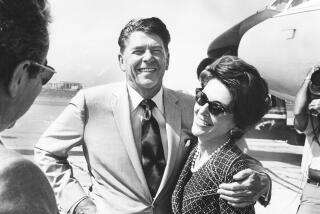Reassessing the ‘Octopus’
There is delicious irony in the fact that the Union Pacific Railroad donated $25,000 this spring to the political committee that is promoting Gov. Arnold Schwarzenegger’s “People’s Reform Program.” Schwarzenegger, after all, casts himself in the mold of progressive Gov. Hiram Johnson, whose election in 1910 broke the oppressive political grip of the Southern Pacific Railroad -- a predecessor of the present Union Pacific -- on state government.
The Evil Railroads
A hundred years ago, the Southern Pacific was the ruthless “Octopus” of muckraking journalist Frank Norris. In Kevin Starr’s history of California’s progressive movement, “Inventing the Dream,” he wrote: “The SP offered the most obvious instance of what was grossly wrong with California: a very few of the super-rich virtually owned the state -- its land, its economy, its government -- and were running it as a private preserve.”
It was a “gilded age plutocracy,” wrote Starr, the former state librarian. The era began in Sacramento in the 1860s with the construction of the Central Pacific line, the western leg of the transcontinental railroad, by Sacramento businessmen Colis P. Huntington, Leland Stanford, Charles Crocker and Mark Hopkins. Political agents of the successor firm, the Southern Pacific, dictated politics in the California cities and in the Legislature, where a chaplain described the members as men who “draw pay, draw corks and draw poker.”
Progressive reformers and good-government politics gradually gathered force during the first decade of the 20th century, culminating in Johnson’s election in 1910, an event still considered a watershed in California politics. Johnson and a friendly Legislature then instituted a sweeping progressive agenda that included the voter initiative, referendum and recall -- the parts of the state Constitution that allowed Schwarzenegger to become governor in 2003. In his campaign, Schwarzenegger attacked “special interests” and vowed to break their power and return control of government to the people (even though his definition of special interests has shrunk largely to public employee unions).
Oops, Not So Evil
As is the case today, it turns out that things were not all black and white in the last century. An exhaustively researched new history paints a very different picture of the Southern Pacific of a century ago. The book is “Sunset Limited, the Southern Pacific Railroad and the Development of the American West 1850-1930” by Richard J. Orsi, professor emeritus of history at Cal State Hayward. Orsi argues that often the Southern Pacific’s corporate interests were consistent with the public welfare, promoted economic development and encouraged enlightened resource practices.
“As a result,” Orsi writes in his preface, “the company was a major force shaping agricultural, industrial, commercial, and urban growth and modernization.” Orsi says his purpose is not to “whitewash” the Southern Pacific’s history but to go beyond the one-dimensional evil image of the railroad and its barons.
Orsi makes a compelling case for the public benefits provided by the Southern Pacific, including extensive healthcare for employees and families and others; promotion of California agriculture through fairs and expositions across the country and abroad; development of irrigation and water supply systems that often were turned over to growing cities and towns, and extensive firefighting facilities (although designed primarily to protect railroad property, they also benefited federal forests and private lands).
The railroad opposed the environmentally devastating practice of hydraulic mining, which tore apart mountains with wasteful high-velocity streams of water, causing debris runoff that still clogs the state’s rivers.
Muir and the Railroad Baron
Southern Pacific’s lobbyists and land agents teamed with naturalist John Muir to win legislation that provided strong federal protection for Yosemite National Park and especially Yosemite Valley. Laws that the company backed created Kings Canyon and Sequoia national parks. The railroads even tried to have the Lake Tahoe basin established as a national park, which would have saved the lake from today’s creeping and unstoppable pollution.
Surprisingly, Muir developed a friendship with E.H. Harriman of the Union Pacific Railroad, which controlled the Southern Pacific from 1901 to 1913. When a bill to remove Yosemite Valley from state mismanagement and make it part of the national park was blocked in the state Senate by economic interests that were exploiting the valley, Muir wrote Harriman: “If you are like-minded and can help us secure passage, I wish you would.” Harriman responded, Orsi writes, by using his personal political clout to shepherd the bill through the Senate.
Rethinking Villains and Heroes
Starr hails Orsi’s work as “part of a corrective going along now in our history.” For all its political evil, the railroad essentially established the infrastructure California needed for expansion and economic growth in the late 19th and early 20th centuries.
Modern-day reformer Schwarzenegger has aligned himself with California business, including the railroad, and is using a direct-democracy tool created by Johnson, the ballot initiative, to seek his own reforms in state government. But now is not 1910. Even the Southern Pacific is not quite what we thought it to be. Schwarzenegger hasn’t cemented his own place in history, but he has far to go to earn his self-comparison to Hiram Johnson.
More to Read
Get the L.A. Times Politics newsletter
Deeply reported insights into legislation, politics and policy from Sacramento, Washington and beyond. In your inbox three times per week.
You may occasionally receive promotional content from the Los Angeles Times.










